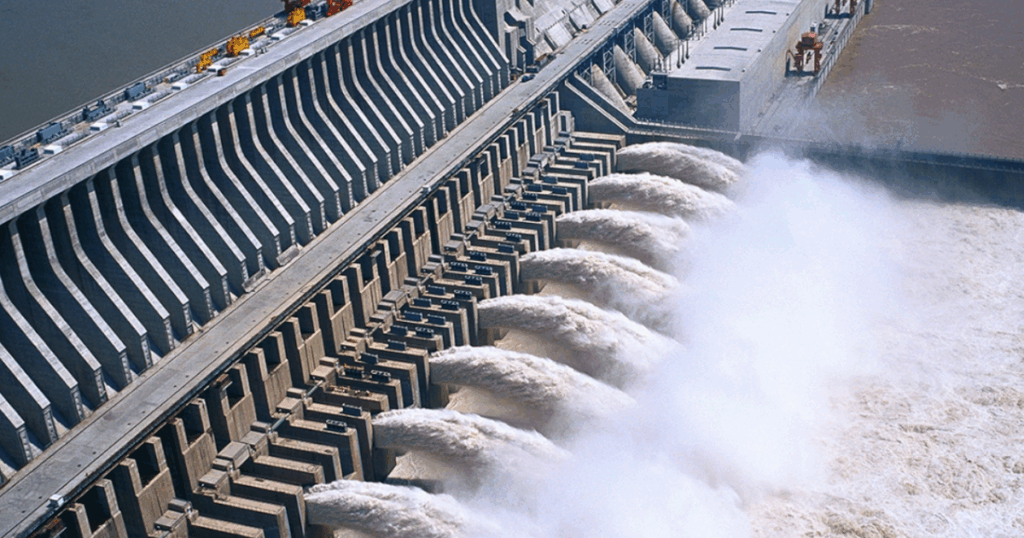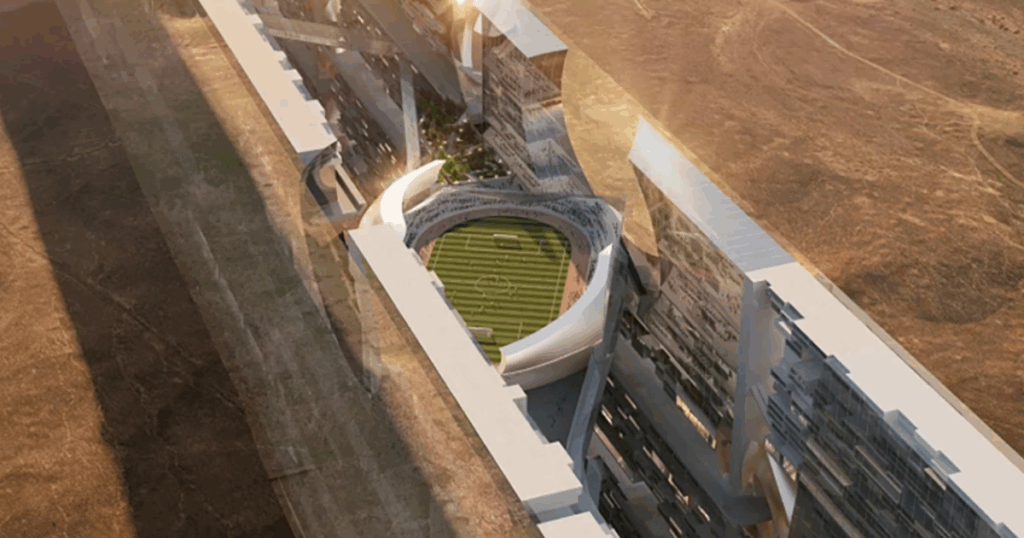Explore the latest news and trends shaping the future of urban development.
You Should Know
- U.S. single-family homebuilding fell to an 11-month low in June, while future building permits hit a two-year low.
- Global electric car sales surged in the first half of 2025 with approximately 5.9 million battery electric vehicles registered—a 37% increase year‑on‑year—driven by robust demand in China (+47%) and Europe (+25%), while U.S. growth lagged at just 7%, resulting in a modest share of global sales.
- The onshore wind energy market is far larger than the offshore market in terms of global installed capacity, accounting for ~90% of all wind power worldwide. The offshore sector is currently facing headwinds from supply chain disruptions, rising material costs, and U.S. regulatory uncertainty.
Worth Watching
- Sinking cities explained.
- Inside OpenAI’s Stargate megafactory.
- Chinese construction site enclosed in world’s largest inflatable dome.
Top Stories

China’s ‘Project of the Century’—World’s Biggest Hydropower Dam—Begins Construction
China has officially begun construction on a megadam on the Yarlung Tsangpo River in Tibet that, once completed, will be the world’s largest hydropower facility by far. The $167 billion dam has been called the “project of the century” by Premier Li Qiang.
Designed to generate 300 billion kilowatt-hours of electricity annually—roughly equivalent to the entire yearly consumption of the United Kingdom—the dam will triple the output of the Three Gorges Dam, currently the world’s largest, and reshape China’s energy landscape.
The project is centered at the Great Bend, a dramatic stretch where the river drops 6,500 feet in just 31 miles, offering some of the most concentrated hydroelectric potential on Earth. China plans to construct five cascading power stations in this steep, narrow terrain to harness the force of the river.
The engineering behind the dam is equally extraordinary. Crews will excavate four 20-kilometer-long tunnels through the Namcha Barwa massif to divert water through turbines before returning it downstream. This involves tunneling through some of the highest and most rugged terrain in the Himalayas.
The core dam structure will use roller-compacted concrete—a drier, stiffer alternative to conventional concrete that is spread by bulldozers and compacted with rollers. Previously used in the Three Gorges project, this method is now being deployed at an even greater scale to enhance durability and control costs—along with roughly 2.4 million tons of steel.
The dam’s location, just 30 kilometers from the contested border with India near Arunachal Pradesh, has raised alarm in New Delhi. Indian officials fear the project could be used to control water flow in the Brahmaputra River, which supports millions downstream in India and Bangladesh. Some have warned it could act as a “water bomb” if weaponized during times of tension.
Beijing sees the project as essential to its “xidiandongsong” policy—sending western electricity eastward—to support its coastal megacities while also developing Tibet’s infrastructure. Authorities claim the project will also meet local energy needs and follow strict ecological protections. Yet critics remain concerned about downstream water security and the displacement of Tibetan communities.
As construction progresses, the dam stands as an unprecedented engineering effort and a high-stakes symbol of China’s energy ambitions and geopolitical posture in Asia.
How NYC Is Achieving Record-Low Traffic Deaths
New York City recently announced that traffic deaths have dropped to their lowest point in recorded history, with just 87 fatalities reported in the first half of 2025—a 32% decline from the same period last year. This progress reflects the impact of an expansive and coordinated effort by the NYC Department of Transportation under the Vision Zero initiative. https://www.nyc.gov/content/visionzero/pages/
Central to the city’s success has been a redesign of its streets. Over the past three years, NYC DOT has installed a record 87.5 miles of protected bike lanes and upgraded another 20 miles with additional physical barriers. Wider lanes were added on major Manhattan avenues like Second, Third, and Ninth to accommodate e-bike use and improve safety for all road users.
The city also acted to make e-bikes safer by working with Citi Bike’s parent company, Lyft, to reduce maximum e-bike speeds—first to 18 mph in 2024, then to 15 mph in 2025. A citywide public education campaign, “Get Smart Before You Start,” launched in 2024 to teach proper e-bike handling and safe speeds. The effort reached residents through TV, radio, digital ads, and subway signage.
NYC expanded its speed camera network to operate 24/7, cutting deadly speeding by more than 90% at equipped intersections. The city also led a regional crackdown on “ghost cars,” seizing over 20,000 vehicles with fake license plates since 2022. These cars were disproportionately involved in fatal crashes.
In high-risk corridors, NYPD increased enforcement of Vision Zero violations, issuing more tickets for speeding, failure to yield, and red-light running.
The Bronx and Queens saw the sharpest declines—43% and 38%, respectively. These boroughs benefited from investments in pedestrian plazas, dedicated bus lanes, and a more connected bicycle network—all designed to reduce conflict between road users and calm traffic.
Hydrogen Energy’s Promise Meets Harsh Reality
The promise of hydrogen energy is compelling. It uses hydrogen gas (H₂) as a clean energy carrier to generate electricity, power vehicles, or fuel industrial operations.
Hydrogen is produced in three main ways: green (renewable-powered electrolysis), blue (natural gas with carbon capture), and gray (fossil fuels without emission controls). It can be stored, transported, and used in fuel cells or burned directly.
Hydrogen can serve sectors difficult to decarbonize—such as steelmaking, long-haul trucking, shipping, aviation, and energy storage. It replaces fossil fuels in high-heat processes, powers fuel cell vehicles with faster refueling than batteries, enables synthetic aviation fuels, and stores renewable power for later use. It may also supplement natural gas in heating, though widespread adoption would require significant infrastructure upgrades.
Despite its potential, hydrogen’s momentum is stalling. Economic and policy headwinds have led to the cancellation of several high-profile projects—including notably Fortescue’s flagship hydrogen initiatives. Just last week, the company scrapped an 80 MW green hydrogen plant in Arizona and a pioneering electrolyser-powered facility in Gladstone, Australia. Fortescue took a $150 million write-down and pointed to deteriorating U.S. hydrogen incentives and unfavorable project economics as key factors behind the pullback.
These setbacks reflect deeper structural challenges. Green hydrogen still costs $4–$6 per kilogram—well above gray hydrogen or conventional fuels. Electrolyser systems remain expensive and hard to scale. Policy support, including incentives like the U.S. hydrogen tax credit, has been slow and unclear. Infrastructure is limited, and demand remains uncertain, with few committed buyers and long lead times for project financing and construction.
While the economics haven’t worsened, they haven’t improved fast enough to justify continued investment at scale. Falling renewable electricity prices, more efficient electrolysers, and clear carbon pricing mechanisms are all needed to make green hydrogen viable. These realities are forcing companies to rethink or downsize their ambitions.

Saudi Arabia Reckons with Its $500 Billion ‘The Line” Project
Saudi Arabia’s epic linear city, The Line, is under strategic review as questions mount over its feasibility, costs, and timeline. Backed by the kingdom’s Public Investment Fund and central to the Vision 2030 plan, The Line aims to transform 105 miles of desert into a futuristic, car-free, zero-carbon urban corridor. But amid financial pressure and logistical complexity, consultants have been brought in to evaluate the project’s scope and viability.
Planned to house up to 9 million people within a dense 34 km² footprint, The Line’s design abandons cars, roads, and sprawl in favor of vertical living and walkable neighborhoods. All daily needs—schools, clinics, shops, and parks—are intended to be within a five-minute walk. Residents will travel end-to-end via a high-speed underground rail line, promising 20-minute cross-city commutes. The entire development will be powered exclusively by renewable energy.
Despite these ambitions, the project faces mounting challenges. What began as a $100–200 billion plan has ballooned to a $500 billion commitment, with cost projections climbing as high as $1 trillion.
Originally slated for completion by 2030, timelines have stretched significantly, with insiders suggesting it may take decades. Only 2.5 km of the 170 km-long city is currently under active construction.
Mass excavation—among the largest in history—modular assembly, and massive piling works are underway in Saudi Arabia’s northwestern desert. But in parallel, job cuts across the broader Neom project are being planned, and consultants suggest a reduced scope may be inevitable.
Critics cite unrealistic expectations and a “yes-man” culture at the project’s leadership. Still, Saudi officials insist The Line remains a strategic priority, noting that such reviews are standard for megaprojects. The city may still be built—but at a slower pace, on a smaller scale, and with greater financial scrutiny.
Big Deals
- Trunk Tools secures $40 million to revolutionize construction with AI.
- BentallGreenOak acquires a massive industrial facility near Tacoma, WA for $176 million.
- BlackRock raises £1 billion for new fund targeting diverse real estate sectors.
- Beitel Group secures $305 million loan for Bronx twin-tower project.
- J.P. Morgan buys Riverbank building in NYC Hell’s Kitchen neighborhood for $243 million.
- MOTOR Ai secures €17 million to enhance autonomous driving technology.
Extra Reads
- Vietnam will ban gasoline motorcycles starting July 2026.
- Who is behind a $5 billion development in Atlanta?
- Oregon pioneers ambitious microgrid framework for energy resilience.
- Colombia launches its first geothermal energy project for sustainability.
- Record-breaking free-span mass timber roof rises in Vancouver.
- Amazon partners to combat energy poverty in England with innovation.
- Australia experiences unprecedented household battery installation surge due to subsidies.
- Utah’s premier development, a mini-city in suburban Salt Lake County, pivots amid competition.
- Pony.ai initiates 24/7 self-driving vehicle tests in major Chinese cities.
- Dallas launches multi-million tree project to combat heat.